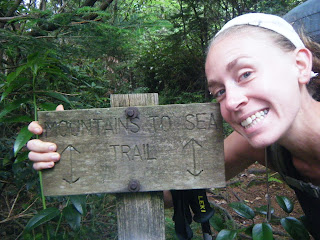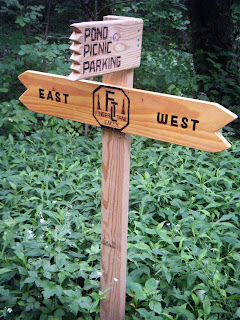As much as I'd like to pretend that the summer is not nearing it's end...evidence of the changing seasons is everywhere I look. Walking the woods, splotches of scarlet are bleeding through the green canopy overhead and yellow streaks by on my periphery when out for a run. Yarrow flowers are browning dried stalks and Wild Carrot's flat-topped doilies are now cupped bird's nests. However....good thing is...there's still a number of summer plants that we can continue to savor and a host of late summer/early fall plants making their appearance. Today I walked no further than my backyard and found enough to keep me busy in the kitchen for a good while....
 |
| Common Burdock (Arctium minus) |
Burdock (Arctium lappa and Arctium minus) is easily identified by its enormous leaves that can grow up to 2 feet long. Leaf margins are curly and the long leafstalks will be solid with a single deep groove if you have Great Burdock (A. lappa) or hollow if you're holding Common Burdock (A. minus). Leaves are smooth and pale green above but covered in a thin wool on their undersides at any age. Burdock begins as a basal rosette in it's first year, and by midsummer of its second year has begun to form a tall, leafy flowering stalk. Flowers are purple and bristley, larger and long-stalked on Great Burdock, smaller and short-stalked on Common Burdock.
 |
| Burdock (Arctium) root |
But enough about what's above ground, let's get to the root of the matter. Burdock roots are edible anytime during their first year's growth or during the beginning of their second year, or in other words, before it has sent up its flowering stalk. The roots are simple to prepare but not so simple to harvest. When Burdock is very young (leaves just 6-8"), the roots will be slender and skinny and easier to dig up, however you'd have to dig a lot of these to get enough for even a side dish. The larger leaved plants will possess very large roots, several feet long in fact, but good luck with digging up that entire root...especially in the rocky soil of the northeast! I managed to dig up some good hunks using a shovel and a sharp trowel, although a digging knife would have served even better.
 |
| Sauteed Burdock with minced garlic and olive oil |
Burdock roots initally look like a dirty, knobby, woody mess, but dirt easily washes off under running water and the not-so-attractive outer skin yields to your average vegetable peeler. Once cleaned and peeled, I sliced roots on the diagonal into disks, simmered them for a few minutes on the stove top, and then sauteed for a few more minutes with some olive oil and minced garlic. If you do the same, be sure to save the water after simmering for a medicinal tea, beneficial as a liver tonic. These burdock morsels would make an excellent side dish with any protein, taking the place of a starch, or a nice addition to a veggie stir-fry. However, I simply savored them as is, enjoying their nutty, subtly sweet, flavor. One of Burdock's greatest nutritive properties, is its inulin, a fructooligiosaccharide that feeds healthy gut flora (think of it as probiotics for your probiotics, essentially a prebiotic) and helpful in leveling blood sugar.
 |
| Goldenrod (Solidago rugosa) |
Speaking of teas...this is a prime time to be harvesting the abundance of Goldenrod that can be found flowering in dry meadows, along woods edges, and roadside, in fact very likely near Burdock and the following plant to be featured. What you see here is Rough-Stemmed Goldenrod (Solidage rugosa), however this is just one of many species that can be found in our region, and all are medicinal. When its flowers are vital and healthy looking, simply snip the stem at the base of the plant to harvest the above-ground-parts (stems, leaves, flowers), chop coarsely, and add to piping hot water. Allow the plant parts to infuse for 10 minutes, keeping the lid on the pot. Use one loose handful of plant to 16 oz of water. I added the portion you see above to a 1 1/2 quarts of water and it made a strong tea.
Tea will be yellow in color and bland tasting with a hint of astringency. Adding honey can brighten up the flavor some if you find it lacking. However, I enjoy drinking it alone for its ability to support kidney function. It can be consumed as a tonic, in this case meaning in moderation and regularly, to alleviate bloating, edema, as a preventative against UTI's, and even to assist in alleviating chronic environmental allergies. This is a gentle medicine that also has the capacity to resolve major issues, especially when used in conjuntion with other herbs. Leaves and stems may also be dried and saved for use throughout the year.
 |
| Berries of Autumn Olive (Elaeagnus umbellata) |
Last on today's menu was something sweet....Autumn Olive (Elaeagnus umbellata) berries. As you can see from the photo, these are just beginning to ripen so get 'em while the gettin' is good! The birds will be quick to pluck these berries from their silvery stems although if you're lucky to find them after a frost, they are even tastier then. Autumn Olive berries has an unsual confluence of flavors, being both sweet, tart, and astringent, and it is one that I adore.
 |
| Underside of Autum Olive (Elaeagnus umbellata) leaf |
Autumn Olive is a large shrub, widely branching, with not only silver speckled berries, shimmery twigs, but also green leaves that bear irridescent undersides. It may be a non-native invasive, escaping from landscaped lots or gamelands where it is planted to attract wildlife, but it is a pretty escapee nonetheless. Berries contain two fibrous seeds that are edible but can be some work to chew. If you prefer your berries seedless, this fruit makes a delicious spread or fruit leather. Simmer the berries, stirring and crushing, strain out seeds, add sugar, and you have a tasty Autumn Olive mash.
With all these wild edible delicacies, how can I not embrace the coming autumn, not to mention those scarlets and yellows will soon mingle with oranges and tans and every earthy color inbetween.
And for those of you attending t
he Finger Lakes Trail Fall Campout and North Country Trail Rendezvous tomorrow in Cortland, NY, I am so looking forward to seeing you there!! Unfortunately, I can only attend Friday and Saturday but I intend to make the most of those two days.
Stay tuned for an update on the classes and presentations I'll be giving in the month of October. The details are all worked out, but there is not enough space in this post to share them!

























